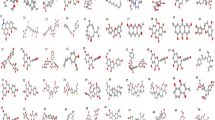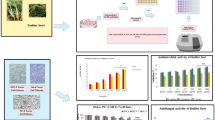Abstract
Achillea fragrantissima (Forssk) Sch. Bip. (Asteraceae) is one of the most important medicinal plant species in Egypt. Phytochemical investigation of the methanolic extract of A. fragrantissima led to the isolation of two phenolic compounds Piceol (1) and Veratric acid (2), which are reported for the first time from this plant. In addition, four known flavonoid compounds; Eupatilin 7-methyl ether (3), Chrysosplenol D (4), Cirsiliol (5), and Cirsimaritin (6) were isolated. Structure elucidation was achieved using spectroscopic techniques, including one-dimensional and two-dimensional nuclear magnetic resonance. Potential cytotoxic activities of the isolated compounds were measured by the sulphorhodamine B assay. Compounds 1, 2, 3, 4, 5, and 6 displayed cytotoxic activity against (MCF7) with IC50 values of 18.2, 15.7, 9.5, 8.33, 3.23, and 3.83 µg/ml, respectively, and against (HepG2) with IC50 values of 19.4, 41.2, 28.3, 20.8, 23.8, and 23.8 µg/ml, respectively. Also there was moderate cytotoxic activity against (A549) with IC50 values of 17.8, 13.6, 3.98, and 10.3 µg/ml for the compounds 1, 2, 4 and 5, respectively, and against (HeLa) with IC50 values of 10.1, 10.4, 4.88, and 3.98 µg/ml for the compounds 3, 4, 5, and 6, respectively. In addition, compounds 4 and 5 showed cytotoxic activity against (PC3) with IC50 values of 3.83 and 3.98 µg/ml, respectively. An in silico study was performed, where cirsiliol (5) and piceol (1) were docked into the active sites of the crystal structures of PI3K and Akt, two protein kinases which are involved in prostate and breast cancer proliferation and survival.









Similar content being viewed by others
References
Alenad AM, Al-Jaber NA, Krishnaswamy S, Yakout SM, Al-Daghri NM, Alokail MS (2013) Achillea fragrantissima extract exerts its anticancer effect via induction of differentiation, cell cycle arrest and apoptosis in chronic myeloid leukemia (CML) cell line K562. J Med Plants Res 7:1561–1567
Bailey C, Danin A (1981) Bedouin plant utilization in Sinai and the Negev. Econ Bot 35:145–162
Bakr RO, Arafa RK, Al-Abd AM, Elshishtawy HM (2014) Phenolics of Achillea fragrantissima growing in Egypt and its cytotoxic activity. J Med Plant Res 8:763–771
Bolous L (2002) Flora of Egypt. Alhadara publishing, Cairo, Egypt, p 249. 3
Bosabalidis A, Gabrielis C, Niopas I (1998) Flavone aglycones in glanular hairs of Origanum x intercedens. Phytochemistry 49:1549–1553
Dayrit FM, Rosario MLG, Cagampang JV, Lagurin LG (1987) Phytochemical studies on the leaves of Vitex negudo, L. (“lagundi”). I. Investigations of the bronchial relaxing constituents. Philipp J Sci 116:403–410
Elsayed EE (2010) Chemistry and biology of Achillea fragrantissima present in Sinai. Master degree thesis, Faculty of Pharmacy, Suez Canal University, Ismailia, Egypt
El-Shanawny M, Sayed H, Ibrahim S, Fayed M (2014) Chemical constituents, anti-inflammatory, and antioxidant activities of Anisotes trisulcus. Bull Fac Pharm Cairo Univ 52:9–14
El-shazly A, Hafez S, Wink M (2004) Comparative study of the essential oils and extracts of Achillea fragrantissima (Forssk.) Sch. Bip. and Achillea santolina L. (Asteraceae) growing in Egypt. Pharmazie 59:226–230
Ezzat SM, Salama MM (2014) A new α-glucosidase inhibitor from Achillea fragrantissima (Forssk.) Sch. Bip. growing in Egypt. Nat Prod Res 28:812–818
Halgren T (1996) Merck molecular force field. I Basis, form, scope, parametization, and performance of MMFF94. J Comput Chem 17:490–498
Hepper FN, Friis I (1994) The plants of Pehr Forsskal’s “flora Ageyptiaco-Arabica”. Kew Publishing, Kew
Hou D, Kumamoto T (2010) Flavonoids as protein kinase inhibitors for cancer chemoprevention: direct binding and molecular modeling. Antioxid Redox Signal 13:691–719
Hou D, Kumamoto T, Ishida H, Hisnaga A (2012) The selectivity and impact of polyphenols-protein kinases interactions for chemoprevention. J Food Drug Anal 20:366–370
Jones G, Willett P, Glen RC, Leach AR, Taylor R (1997) Development and validation of a genetic algorithm for flexible docking. J Mol Biol 267:727–748
Kong D, Zhang Y, Yamori T, Duan H, Jin M (2011) Inhibitory activity of flavonoids against class I phosphatidylinositol 3-Kinase isoforms. Molecules 16:5159–5167
Lin Y, Shi R, Wang X, Shen H (2008) Luteolin, a flavonoid with potentials for cancer prevention and therapy. Curr Cancer Drug Targets 8:634–646
Mustafa E, Abu Zarga M, Sabri S, Abdalla S (1995) Effects of Cirsiliol, a flavone isolated from Achillea fragrantissima, on rat isolated smooth muscle. Int J Pharmacogn 33:204–209
Oliver-Bever B, Zahnd GR (1979) Plants with oral hypoglycemic activity. Q J Crude Drug Res 17:139–196
Ozenda P (1991) Flore et ve´ge´tation du Sahara. Ed. du CNRS, Paris
Saeidnia S, Gohari AR, Mokhber-Dezfuli N, Kiuchi F (2011) A review on phytochemistry and medicinal properties of the genus Achillea. DARU 19:173–186
Sathiyamoorthy P, Lugasi-Evgi H, Schlesinger P, Kedar I, Gopas J, Pollack Y, Golan-Goldhirsh A (1999) Screening for cytotoxic and antimalarial activities in desert plants of the Negev and Bedouin market plant products. Pharm Biol 37:188–195
Shukla S, Gupta S (2010) Apigenin: a promising molecule for cancer prevention. Pharm Res 27:962–978
Shukla S, Bhaskaran N, Babcook MA, Fu P, MacLennan GT, Gupta S (2014) Apigenin inhibits prostate cancer progression in TRAMP mice via targeting PI3K/Akt/FoxO pathway. Carcinogenesis 35:452–460
Si XT, Zhang ML, Shi QW, Kiyota H (2006) Chemical constituents of the plants in the genus Achillea. Chem Biodivers 3:1163–1180
Sincich F (2002) Bedouin traditional medicine in the Syrian steppe. FAO, Rome, p 114–115
Skehan P, Storeng R, Scudiero D, Monks A, McMahon J, Vistica D, Warren JT, Bokesch H, Kenny S, Boyd M (1990) New colorimetric cytotoxicity assay for anticancer drug screening. J Natl Cancer I 82:1107–1112
Soltan MM, Zaki AK (2009) Antiviral screening of forty-two Egyptian medicinal plants. J Ethnopharmacol 126:102–107
Tackholm V (1974) Students’ Flora of Egypt, 3rd edn. Co-operative printing company, Beirut, p 577
Tong X, Pellin J (2013) Targeting the PI3K/Akt/mTOR axis by apigenin for cancer prevention. Anticancer agents Med Chem 13:971–978
Valant-Vetschera K, Wollenweber E (2001) Exudate flavonoid aglycones in the alpine species of Achillea sect. Ptarmica: Chemosystematics of A. moschata and related species (Compositae-Anthemideae). Biochem Syst Ecol 29:149–159
Vichai V, Kirtikara K (2006) Sulphorhodamine B colorimetric assay for cytotoxicity screening. Nat Protoc 1:1112–1116
Wang H, Chou Y, Hong Z, Chen H, Chang Y, Yang W, Chang H, Mai C, Chen C (2011) Bioconstituents from stems of Synsepalum dulcificum Daniell (Sapotaceae) inhibit human melanoma proliferation, reduce mushroom tyrosinase activity and have antioxidant properties. J Taiwan Inst Chem Eng 42:204–211
Yaniv Z, Dani A, Friedman J, Palevitch D (1987) Plants used in treatment of diabetes in Israel. J Ethnopharmacol 19:145–151
Youn U, Lee Y, Joen H, Shin H, Son Y, Nam J, Han A, Seo E (2010) A pyridyl alkaloid and benzoic acid derivatives from the rhizomes of Anemarrhena asphodeloides. Nat Prod Sci 16:203–206
Acknowledgements
We are grateful to pro. Abd-Elraouf M., Faculty of Science, Sues Canal University, Ismailia, Egypt, for taxonomic identification of the plant.
Author information
Authors and Affiliations
Corresponding author
Ethics declarations
Conflict of interest
The authors declare that they have no competing interests.
Electronic supplementary material
Rights and permissions
About this article
Cite this article
Awad, B.M., Habib, E.S., Ibrahim, A.K. et al. Cytotoxic activity evaluation and molecular docking study of phenolic derivatives from Achillea fragrantissima (Forssk.) growing in Egypt. Med Chem Res 26, 2065–2073 (2017). https://doi.org/10.1007/s00044-017-1918-6
Received:
Accepted:
Published:
Issue Date:
DOI: https://doi.org/10.1007/s00044-017-1918-6




